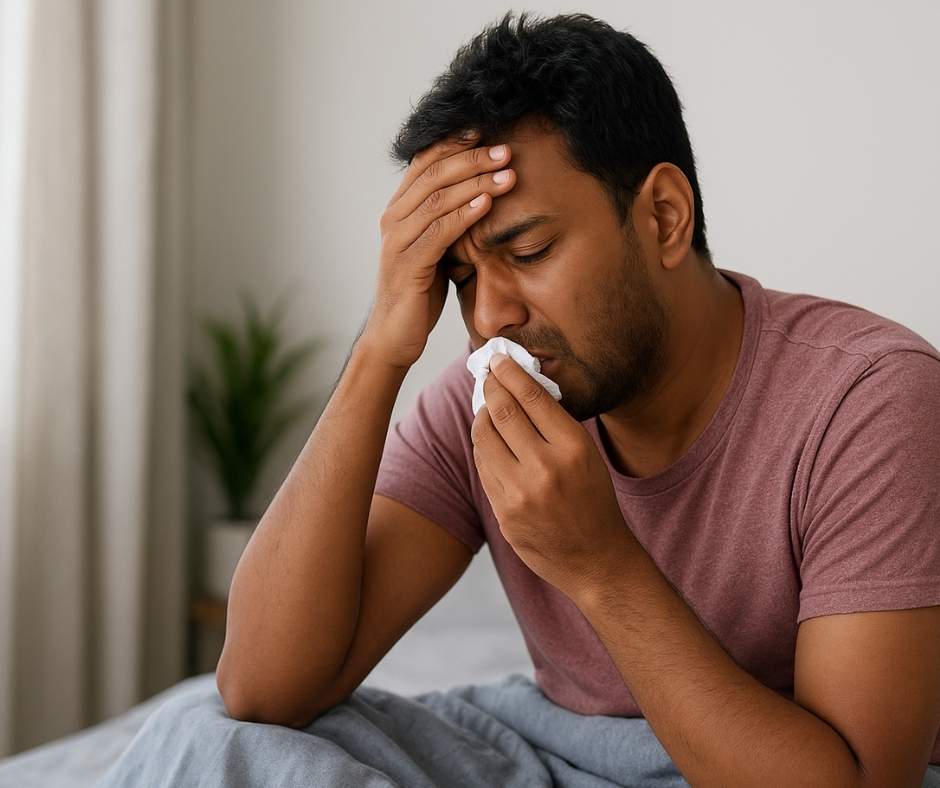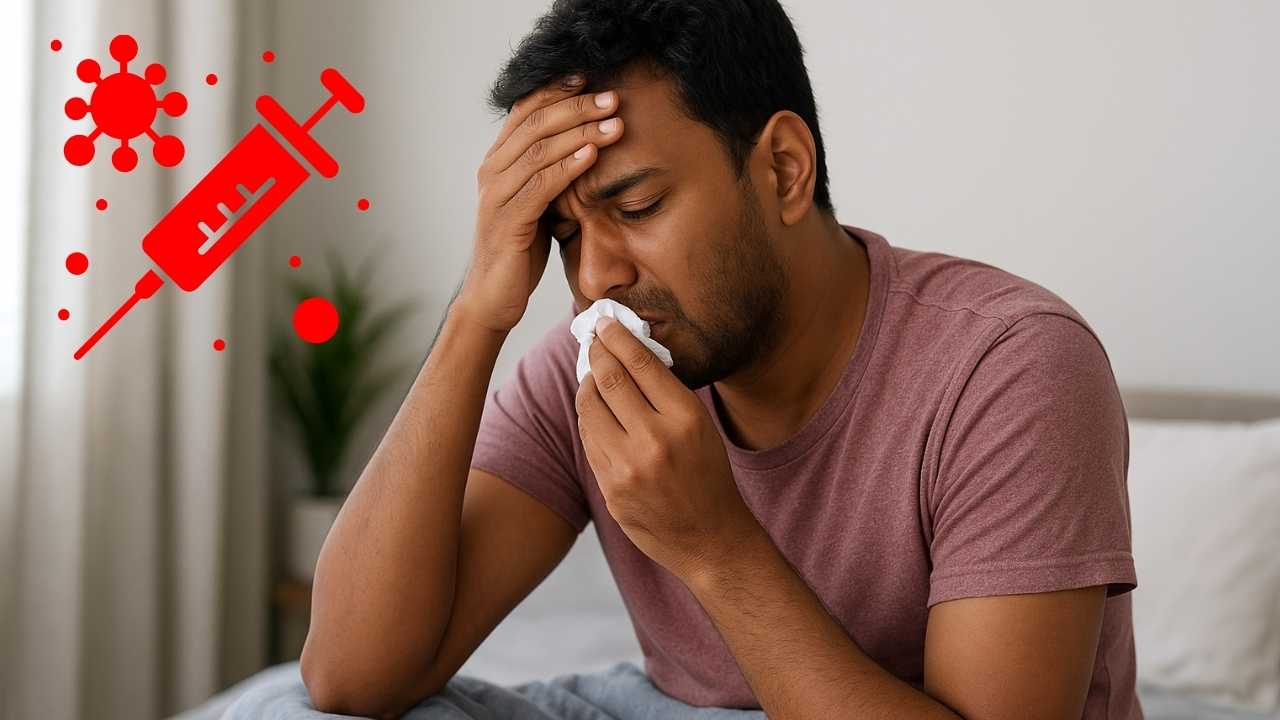Delhi-NCR H3N2 Flu Surge: In September 2025, Delhi and its surrounding NCR cities (Gurugram, Noida, Faridabad, Ghaziabad) are witnessing a sharp and concerning rise in viral illnesses. A large number of households are affected, the dominant strain is Influenza A subtype H3N2, and the features of illness are harsher than in many past flu seasons.
Table of Contents
Key findings in Delhi-NCR H3N2 Flu Surge:
| A LocalCircles survey (approx. 11,000 households) shows 69% of households presently have one or more members with viral / flu / fever-like symptoms, up from ~54% in March 2025. |
| In many homes, multiple family members are ill: about 37% reported four or more people with symptoms; ~32% reported one to three people ill. |
| More severe manifestations are being observed than in mild seasonal flu: fevers that won’t break easily with over-the-counter medicines, hospitalisations for pneumonia, bronchitis, and respiratory distress, especially among vulnerable populations (children, elderly, people with comorbid conditions). |
| More severe manifestations are being observed than in mild seasonal flu: fevers that won’t break easily with over-the-counter medicines, hospitalisations for pneumonia, bronchitis and respiratory distress, especially among vulnerable populations (children, elderly, people with comorbid conditions). |
| Recovery is slower too: while mild cases may still resolve in 5-7 days, many are taking up to 10 days or more. Some post-illness symptoms (cough, weakness) linger beyond the acute phase. |
Contributing factors include monsoon-related weather changes (humidity, waterlogging), possible contamination of water sources, crowded living conditions, and perhaps waning immunity. The fact that Delhi-NCR H3N2 Flu tends to mutate and sometimes escape existing immunity or vaccine coverage may be making things worse.
Public Health bodies like the Indian Council of Medical Research (ICMR) also report rising positivity for H3N2 and RSV (Respiratory Syncytial Virus) in surveillance samples.
Related: Blood Cancer Awareness Month 2025
Why Delhi-NCR H3N2 Flu Is More Concerning Than “Regular Flu”

Many people have experienced flu or flu-like illness before; what makes this season more worrying:
- Higher spread and reach
The percentage of households affected (69%) is unusually high, and many with multiple sick members. - Longer durations and more severe symptoms
Fevers that don’t reduce easily with standard antipyretics; more hospital visits; and more respiratory distress. - Vulnerability
Those with existing lung, heart, metabolic, or immune-compromising conditions, children, and elders are at higher risk of serious outcomes. - Possible under-treatment or delay
Because people assume it’s just “a cold” or “seasonal flu,” many wait, self-medicate, or do not get diagnosed until complications develop. This exacerbates severity. - Limited vaccine uptake/awareness
While flu vaccines (often quadrivalent covering H3N2 among other strains) are available, in India their uptake remains low due to cost, limited awareness, and because they are not universally included in government immunisation programmes.
All the above make it not just a matter of more people catching flu, but a matter of health system stress, higher complications, and the need for better preventive and early care measures.
Also Read: Heart Disease Symptoms, Cardiologist-Recommended Tests, Treatment & Natural Care
H3N2 flu Symptoms: What to Look Out For
Being able to spot H3N2 flu early helps both individuals and their caregivers respond promptly. Some symptoms overlap with common respiratory illness, but keep an eye out for:
- Sudden onset of high fever (often > 101°F / 38.5°C), sometimes persisting several days.
- Persistent cough, sore throat.
- Nasal congestion, runny or blocked nose.
- Body aches, muscle pain; headaches; fatigue / lethargy.
- Sometimes gastrointestinal symptoms (nausea, vomiting, loose motions) in some patients.
- Difficulty breathing or shortness of breath, chest tightness in more serious cases.
- Weakness lingering after fever subsides; slow recovery.
If symptoms worsen, especially breathing problems, extreme fatigue, or high, unrelenting fever, medical care should be sought.
You may like: What is Frontotemporal Dementia? Understanding Bruce Willis’ Diagnosis
What You Can Do: Prevention & Care for H3N2 flu
Preventing illness or reducing its severity depends on both community-level measures and individual habits. Here are what experts are recommending:
Essential Preventive Measures
- Wash hands frequently with soap and water for at least 20 seconds; use alcohol-based sanitizer if not possible.
- Wear masks, especially in crowded places or public transport.
- Maintain respiratory etiquette: cover nose and mouth when coughing/sneezing; use tissue or elbow.
- Disinfect commonly touched surfaces (door knobs, handles, phones, stair rails).
- Avoid close contact with people who are sick; if you are sick, stay home to avoid spreading it.
- Stay well-hydrated; eat a balanced, nutritious diet rich in vitamins (especially Vitamin C, D) to support immune function.
- Adequate rest and sleep. Stress reduction helps.
- Ventilate indoor spaces—open windows, allow fresh air flow.
Medical / Healthcare-oriented Steps
- Flu vaccination: Highly recommended, especially if you are at high risk (children, elderly, pregnant women, those with chronic illness). Even if the vaccine match is not perfect, it reduces severity, prevents hospitalisation.
- Early diagnosis and treatment: If symptoms persist beyond a few days, or if they are severe, seek medical attention. Antiviral drugs (e.g., Oseltamivir) are more effective when started early.
- Avoid unnecessary use of antibiotics (unless a secondary bacterial infection is identified). Antibiotic misuse is common and can lead to resistance and side effects.
- Monitor high-risk individuals more closely: children, people with lung, heart, or metabolic conditions often need closer observation.
Important Article: The Effects of Dehydration: Symptoms, Diseases, Tests, and Prevention
What Authorities & Communities Should Do

The responsibility of curbing the H3N2 flu surge cannot rest on individuals alone. Authorities and community bodies must take coordinated steps to reduce the spread and protect vulnerable populations. Strengthening disease surveillance is a top priority so that trends are spotted early and interventions can be made swiftly. Public awareness campaigns are equally important to educate citizens about symptoms, prevention, and the importance of timely medical care.
Misconceptions about flu vaccines should be addressed, and efforts should be made to improve access, whether through subsidies, public immunisation drives, or mobile vaccination camps.
Healthcare facilities also need to be prepared for the rise in patient numbers, ensuring adequate beds, medicines, and diagnostic facilities are available. Environmental measures like improving sanitation, preventing waterlogging, and safeguarding water supplies from contamination can play a significant role in reducing the overall disease burden. Encouraging or even enforcing mask usage in crowded spaces, schools, and offices during peaks can help limit transmission. Together, these systemic and community-driven measures can help contain the outbreak and reduce strain on the healthcare system.
Related: Microplastics in Human Reproductive Fluids: A Wake‑Up Call for Fertility
Practical Advice: What to Do If You or Someone in Your Household Gets Affected by H3N2 flu
- Isolate the sick person as much as possible (separate room, separate utensils, etc.).
- Maintain hygiene—frequent hand-washing, clean surfaces.
- Supportive care: rest, fluids (water, oral rehydration), warm healthy foods.
- Use OTC medicines for fever, aches, etc., as per the doctor’s advice. Avoid self-medication with strong drugs unless prescribed.
- Monitor for warning signs: trouble breathing, persistent high fever, dehydration, confusion, chest pains. If these occur, seek medical help immediately.
- Even after the fever resolves, cough and weakness may linger; don’t rush back to full activity.
Read Carefully: Why Regular Check-ups during Pregnancy Is Essential? Know Everything About…
What to Expect & How To Stay Calm
During any widespread flu surge, fear and uncertainty can spread as fast as the virus itself. However, understanding what to expect can help ease anxiety. In most cases, H3N2 flu presents with mild to moderate symptoms that resolve with supportive home care. Recovery may take longer than the usual seasonal flu, often stretching up to ten days, but the majority of people do recover fully with rest, hydration, and proper medical attention where necessary.
Healthcare systems may see an increase in outpatient visits and hospital admissions, particularly among children, the elderly, and people with pre-existing conditions. This does not mean the situation is unmanageable. Preventive measures, early medical consultation, and a calm, informed approach can limit complications. By staying vigilant but not panicking, households can navigate this challenging flu season with resilience and care.
Interesting one: What is Lyme Disease? The Illness That Justin Timberlake Was Diagnosed With
Bottom Line: Staying Safe During Delhi-NCR H3N2 Flu Surge
Delhi-NCR is facing one of the more serious seasonal flu/H3N2 surges in recent times. The data (- 69% households, prolonged symptoms, more hospital admissions) show this is beyond regular flu patterns. What matters now is swift action: prevention, early detection, appropriate care, vaccination, public awareness.
Related Sources: India Today, Hindustan Times, NDTV, Mint, The New Ind. Exp.
